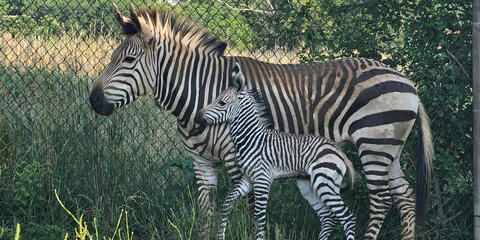Physical Description
The spider tortoise is named for the web-like pattern of yellow lines on its dark brown or black carapace, or shell. It has a dark head with yellow spots and a yellow, semi-hinged plastron that allows the tortoise to pull its head and front legs into its shell for protection. The tortoise's legs and tail are generally brown. Males are slightly smaller than females and also have longer, thicker tails with a more developed terminal spine than females.
Spider tortoises spend time under vegetation to regulate their body temperature. They are most active during the wet season from November to April when vegetation is plentiful. During the dry season, these tortoises may aestivate—or enter a period of dormancy similar to hibernation—by burrowing into the sand.
Size
The spider tortoise's carapace can grow up to about 7 inches (17 centimeters). It is the smallest of the four endemic tortoise species of Madagascar. Females average just less than 5 inches (12 centimeters) in length and are usually slightly larger than males, which average 4.5 inches (11 centimeters).
Native Habitat
Lifespan
Although no hard data exists, spider tortoises are believed to live up to 70 years.
Food/Eating Habits
Spider tortoises eat grasses, young leaves, roots, insects and even cow dung that contains insect larvae. At the Smithsonian's National Zoo, they eat a prepared salad comprised of mixed leafy greens, such as collard greens, kale and chicory. They are also fed tortoise pellets.
Reproduction and Development
Little is known about spider tortoise reproduction. When the wet season arrives and their dormancy period ends, they begin to look for a mate. Female spider tortoises only lay one egg per clutch, so populations cannot quickly recover from a decrease in numbers. The tortoise eggs incubate for about 220 to 250 days before hatching.
Conservation Efforts
Spider tortoises are listed as critically endangered by the International Union for Conservation of Nature's Red List and CITES Appendix I. They are threatened by habitat loss, and it is estimated that their habitats have decreased at a rate of 1.2 percent per year. Agriculturists use fire to burn back spiny and woody vegetation to maintain grasslands that are palatable for livestock.
These fires eliminate the very habitat that spider tortoises require to thrive and can fragment existing patches of habitat in which the tortoises still remain. Invasive plants have also made certain parts of remaining forests unsuitable for the spider tortoise.
The domestic production and demand for charcoal also drives habitat loss. Charcoal is almost considered a staple resource for many urban residents in Madagascar, many of whom came from rural areas where wood-burning was a primary source of energy or cannot afford gas. This demand fuels an industry that provides a livelihood to thousands of rural residents and families, especially in the wake of floods that wash out agricultural activities that could otherwise support a household.
To make charcoal, harvesters cut down branches and trees as base materials. It is largely produced in the south of Madagascar, with wood from spiny forests a preferred material. A lack of production regulation and an increasing demand leads to the destruction of the spiny forests that host spider tortoise habitat.
Spider tortoises are also subjected to poaching and illegal collection for the international pet trade. Locally, they are hunted for meat, especially as radiated tortoise populations decrease. Internationally, their unique coloration and small size makes them a popular pet. Although their CITES Appendix I status bans international trade, several turtles are still smuggled out to collectors, especially in Japan, Europe, North America and Southeast Asia.
If spider tortoise populations continue to decrease, they will likely become extinct. International efforts are in place to conserve their populations, and there are two national parks in Madagascar that offer some protection for the species. More education to prevent poaching and resource degradation is needed.
The Smithsonian's National Zoo successfully hatched two spider tortoises in 2015, a remarkable accomplishment given how challenging it is to breed this species.
Help this Species
- Reduce, reuse and recycle — in that order! Cut back on single-use goods, and find creative ways to reuse products at the end of their life cycle. Choose recycling over trash when possible.
- Choose your pets wisely, and do your research before bringing an animal home. Exotic animals don’t always make great pets. Many require special care and live for a long time. Tropical reptiles and small mammals are often traded internationally and may be victims of the illegal pet trade. Never release animals that have been kept as pets into the wild.
- Share the story of this animal with others. Simply raising awareness about this species can contribute to its overall protection.
- Less is more. Cut down on the demand for resources by consuming less. Buy only what you need, and look for pre-owned or repurposed items before purchasing something brand new.



